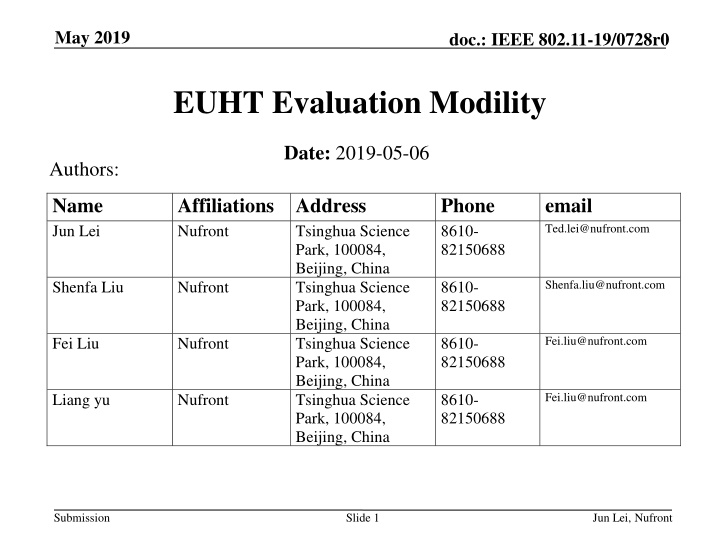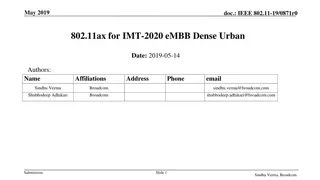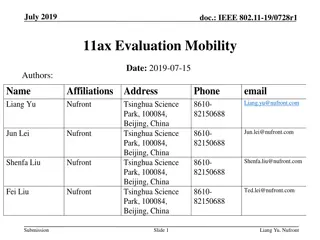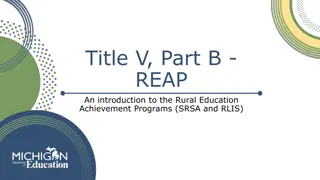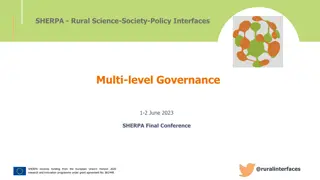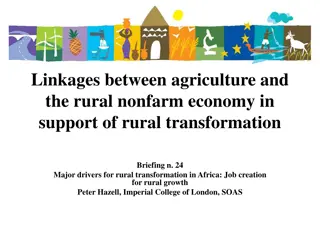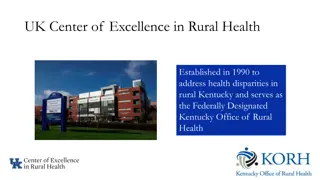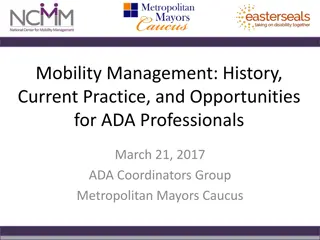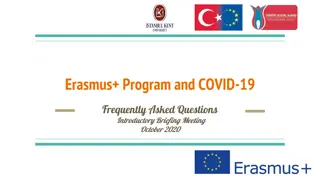Preliminary Results of EUHT Simulations on Mobility in Rural eMBB Scenario
This presentation showcases the preliminary results of EUHT simulations focusing on mobility in a rural enhanced Mobile Broadband (eMBB) environment. The simulations align with ITU-R methodology for self-evaluation of Radio Access Technology (RAT) for IMT-2020, demonstrating EUHT's ability to meet mobility requirements in rural eMBB scenarios.
Uploaded on Mar 03, 2025 | 1 Views
Download Presentation

Please find below an Image/Link to download the presentation.
The content on the website is provided AS IS for your information and personal use only. It may not be sold, licensed, or shared on other websites without obtaining consent from the author.If you encounter any issues during the download, it is possible that the publisher has removed the file from their server.
You are allowed to download the files provided on this website for personal or commercial use, subject to the condition that they are used lawfully. All files are the property of their respective owners.
The content on the website is provided AS IS for your information and personal use only. It may not be sold, licensed, or shared on other websites without obtaining consent from the author.
E N D
Presentation Transcript
May 2019 doc.: IEEE 802.11-19/0728r0 EUHT Evaluation Modility Date: 2019-05-06 Authors: Name Jun Lei Affiliations Address Nufront Phone 8610- 82150688 email Ted.lei@nufront.com Tsinghua Science Park, 100084, Beijing, China Tsinghua Science Park, 100084, Beijing, China Tsinghua Science Park, 100084, Beijing, China Tsinghua Science Park, 100084, Beijing, China Shenfa.liu@nufront.com Shenfa Liu Nufront 8610- 82150688 Fei.liu@nufront.com Fei Liu Nufront 8610- 82150688 Fei.liu@nufront.com Liang yu Nufront 8610- 82150688 Submission Slide 1 Jun Lei, Nufront
May 2019 doc.: IEEE 802.11-19/0728r0 Abstract This presentation is a follow up work of the proposal about joint submission to ITU as IMT-2020 standard [1]. In this contribution, we present the preliminary results of EUHT [2] simulations on mobility in rural eMBB scenario. The simulations adhere to the methodology specified by ITU-R for self-evaluating a RAT for IMT-2020 [3]. The preliminary results show that EUHT can meet the ITU requirements on mobility in rural eMBB scenario[4]. Submission Slide 2 Jun Lei, Nufront
May 2019 doc.: IEEE 802.11-19/0728r0 Abbreviation RIT ( Radio Interface Technology) URLLC Ultra-Reliable and Low Latency Communications eMBB enhanced Mobile Broadband mMTC (massive Machine Type Communication) 3GPP R15 3GPP Release 15 3GPP R16 3GPP Release 16 NSA Non-Standalone EUHT Enhanced Ultra High Throughput Submission Slide 3 Jun Lei, Nufront
May 2019 doc.: IEEE 802.11-19/0728r0 Outline Objective Simulation Configuration Simulation Assumption Mobility Simulation Results Mobility Interruption Time Analysis Control Plane Latency Analysis Conclusion Next Step References 1. 2. 3. 4. 5. 6. 7. 8. 9. Submission Slide 4 Jun Lei, Nufront
May 2019 doc.: IEEE 802.11-19/0728r0 Objective In the previous meeting, it was proposed that 11ax and EUHT are combined together to be submitted to ITU as SRIT (set of RIT) [1]. In [1], EUHT is proposed to meet the requirements of the following scenarios Rural eMBB, Urban Marco URLLC and Urban Macro mMTC The self-evaluation results must be submitted together with the technical documents before July 1st according to ITU[5]. The self-evaluation results of EUHT on mobility, control plane latency and mobility interruption time in rural eMBB scenario are shown in this contribution. Submission Slide 5 Jun Lei, Nufront
May 2019 doc.: IEEE 802.11-19/0728r0 Simulation Configuration 1. 2. 3. 4. 5. 6. Simulation bandwidth : 20 MHz Carrier Frequency: 4GHz ( Higher Doppler than 700MHz) BS Tx power : 49 dBm, UE Tx power: 23 dBm BS Antenna gain: 8 dBi, UE antenna gain: 0 dBi BS noise figure: 5 dB, UE noise figure : 7 dB BS antenna configuration : dual polarization 8Tx/8Rx with 8 dBi gain in intended direction. UE antenna configuration : dual polarization 8Tx/8Rx with with 0 dBi gain. The complete configuration is specified in the ITU-R guidelines for self-evaluating a RAT ([3]). 7. 8. Submission Slide 6 Jun Lei, Nufront
May 2019 doc.: IEEE 802.11-19/0728r0 Simulation Assumptions 1. TCH Payload : 1500 Byte 2. QPSK, 16QAM 3. LDPC, 1/2, 3/4 code rate, codeword size: 2688 4. single spatial stream 5. DPI( Dedicated Reference Symbol Period Interval) in time domain is 8 Insert one DRS symbol every 8 TCH OFDM symbols 6. Channel estimation based on 2-Dimension linear interpolation Performance will be further improved with L-MMSE channel estimation 7. Maximum Ratio Combining 8. Min-sum LDPC decoding Submission Slide 7 Jun Lei, Nufront
May 2019 doc.: IEEE 802.11-19/0728r0 Minimum Requirements The minimum requirements of mobility in [4] are quoted as follows Submission Slide 8 Jun Lei, Nufront
May 2019 doc.: IEEE 802.11-19/0728r0 Simulation Procedure (1) The mobility simulation procedure is quoted as follows [3] Step 1: Run uplink system-level simulations, identical to those for average spectral efficiency, and 5th percentile user spectral efficiency except for speeds taken from Table 4 of Report ITU-R M.2410-0, using link-level simulations and a link-to-system interface appropriate for these speed values, for the set of selected test environment(s) associated with the candidate RITs/SRITs and collect overall statistics for uplink SINR values, and construct CDF over these values for each test environment. Step 2: Use the CDF for the test environment(s) to save the respective 50th-percentile SINR value. Submission Slide 9 Jun Lei, Nufront
May 2019 doc.: IEEE 802.11-19/0728r0 Simulation Procedure (2) Step 3: Run new uplink link-level simulations for the selected test environment(s) for either NLOS or LOS channel conditions using the associated speeds in Table 4 of Report ITU-R M.2410-0, as input parameters, to obtain link data rate and residual packet error ratio as a function of SINR. The link-level simulation shall use air interface configuration(s) supported by the proposal and take into account retransmission, channel estimation and phase noise impact. Step 4: Compare the uplink spectral efficiency values (link data rate normalized by channel bandwidth) obtained from Step 3 using the associated SINR value obtained from Step 2 for selected test environments, with the corresponding threshold values in the Table 4 of Report ITU-R M.2410-0. Step 5: The proposal fulfils the mobility requirement if the spectral efficiency value is larger than or equal to the corresponding threshold value and if also the residual decoded packet error ratio is less than 1%, for all selected test environments. For the selected test environment it is sufficient if one of the spectral efficiency values Submission (using either NLOS or LOS channel conditions) fulfils the threshold. Slide 10 Jun Lei, Nufront
May 2019 doc.: IEEE 802.11-19/0728r0 Simulation Results 120km/h MCS3: 16QAM, code rate Median SINR: 4.6dB@120km/h Spectral Efficiency at 4.6dB is 1.23 bit/s/Hz > 0.8 bit/s/Hz Submission Slide 11 Jun Lei, Nufront
May 2019 doc.: IEEE 802.11-19/0728r0 Simulation Results 500 km/h MCS2: QPSK, code rate Median SINR: 2.9dB@500km/h Spectral Efficiency at 2.9dB is 0.9 bit/s/Hz > 0.45 bit/s/Hz Submission Slide 12 Jun Lei, Nufront
May 2019 doc.: IEEE 802.11-19/0728r0 Mobility Interruption Time Analysis 1. The message handover Request is send from Source BS to target BS, which carry the information with the resources of the UE After the source BS received feedback message Handover Response from Target BS, the both BS will connect with UE at the same time. Finally, the Target BS establish connection with UE , and inform the source BS to release UE the UE can always exchange user plane packets with BS during the mobility transitions with 0ms mobility interruption time 2. 3. 4. Submission Slide 13 Jun Lei, Nufront
May 2019 doc.: IEEE 802.11-19/0728r0 Control plane latency CP latency (ms) Step Description 1 Delay due to RaPn scheduling period 0 2 Transmission of RaPn 0.5 3 Processing delay in BS including Rapn detection and Caculation Timing Advance 2 4 Assign UL Source for Ra Request 0.5 5 UE Processing Delay of Constructing RaReq message,including UEid and bytes will be send 1 6 Transmission of Ra Request 0.5 7 Processing delay in BS including analysis of Ra Request and Constructing Ra Response 2 8 Transmission of Ra Response 0.5 9 Processing delay in UE of Ra Response 1 Total delay 8 ( ITU: 20ms) Note: This is an example with 2ms frame length. If 1ms frame length is configured ,the CP latency will decrease. Submission Slide 14 Jun Lei, Nufront
May 2019 doc.: IEEE 802.11-19/0728r0 Conclusion The preliminary evaluation results show that EUHT can meet the following requirements of IMT-2020 Mobility in rural eMBB scenario Mobility Interruption Time Control Plane Latency Submission Slide 15 Jun Lei, Nufront
May 2019 doc.: IEEE 802.11-19/0728r0 Next Step Develop the system level simulation platform and perform average spectral efficiency evaluation in rural eMBB scenario. Finish the submission documents sRIT description : 70% done Self Evaluation Report: 40% done Submission Slide 16 Jun Lei, Nufront
May 2019 doc.: IEEE 802.11-19/0728r0 Reference [1] IEEE 802.11-19/0625r0, Proposal to Cooperate to Submit 5G Standards [2] IEEE 802.11-19/0626r0, EUHT Technical Brief [3] Report ITU-R M.2412-0 (10/2017), Guidelines for evaluation of radio interface technologies for IMT-2020 [4] Report ITU-R M.2410-0 (11/2017), Minimum requirements related to technical performance for IMT-2020 radio interface(s) [5] Report ITU-R M.2411-0 (11/2017) , Requirements, evaluation criteria and submission templates for the development of IMT-2020 [6] Document 5D/1050-E, Preliminary Description Template and Self- Evaluation of 3GPP 5G candidate for inclusion in IMT-2020 Submission Slide 17 Jun Lei, Nufront
